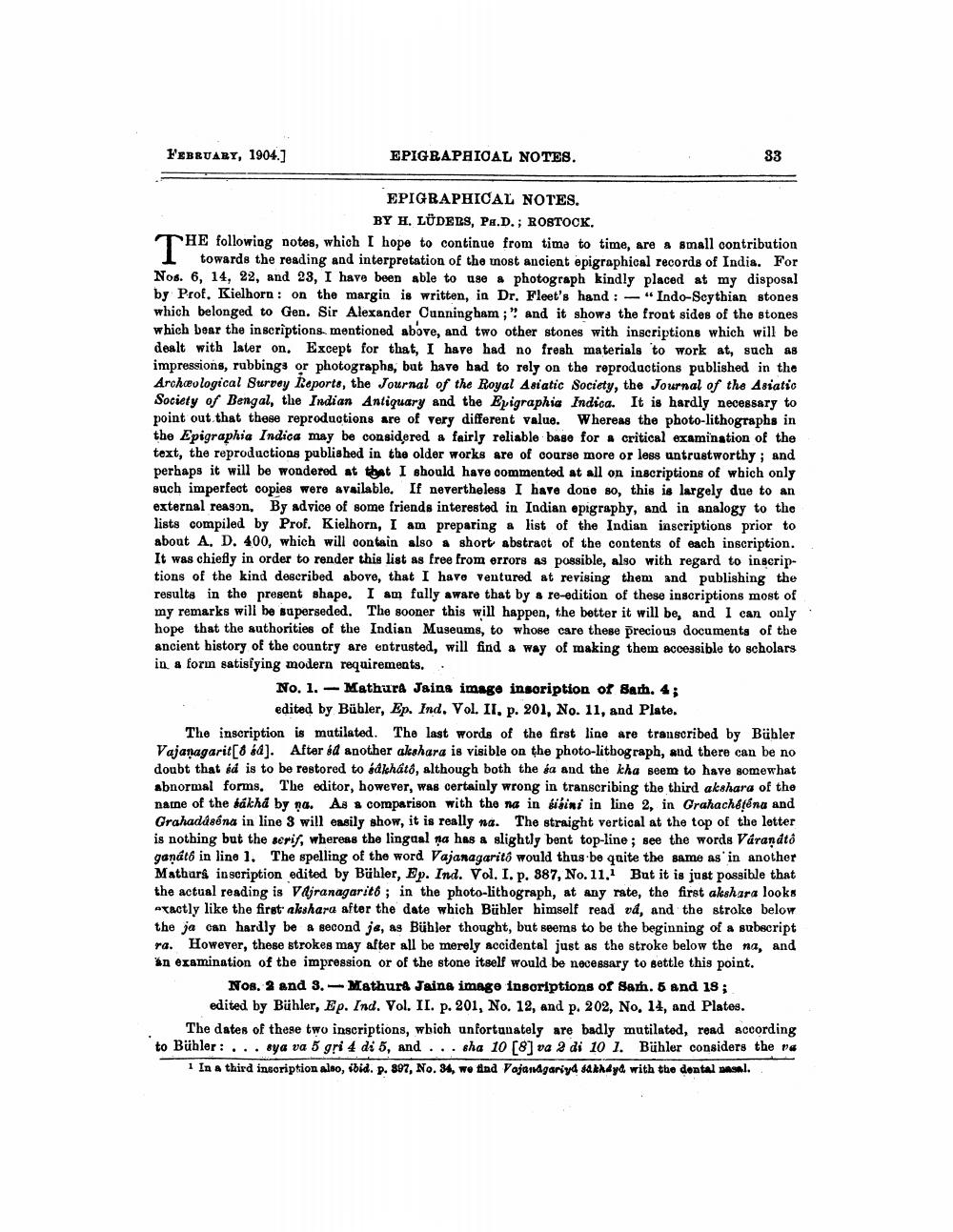________________
FEBRUARY, 1904.]
EPIGRAPHICAL NOTES.
EPIGRAPHICAL NOTES. BY H. LÜDERS, PH.D.; ROSTOCK.
THE
HE following notes, which I hope to continue from time to time, are a small contribution towards the reading and interpretation of the most ancient epigraphical records of India. For Nos. 6, 14, 22, and 23, I have been able to use a photograph kindly placed at my disposal by Prof. Kielhorn: on the margin is written, in Dr. Fleet's hand: "Indo-Scythian stones which belonged to Gen. Sir Alexander Cunningham;" and it shows the front sides of the stones which bear the inscriptions mentioned above, and two other stones with inscriptions which will be dealt with later on. Except for that, I have had no fresh materials to work at, such as impressions, rubbings or photographs, but have had to rely on the reproductions published in the Archaeological Survey Reports, the Journal of the Royal Asiatic Society, the Journal of the Asiatic Society of Bengal, the Indian Antiquary and the Epigraphia Indica. It is hardly necessary to point out that these reproductions are of very different value. Whereas the photo-lithographs in the Epigraphia Indica may be considered a fairly reliable base for a critical examination of the text, the reproductions published in the older works are of course more or less untrustworthy; and perhaps it will be wondered at that I should have commented at all on inscriptions of which only such imperfect copies were available. If nevertheless I have done so, this is largely due to an external reason. By advice of some friends interested in Indian epigraphy, and in analogy to the lists compiled by Prof. Kielhorn, I am preparing a list of the Indian inscriptions prior to about A. D. 400, which will contain also a short abstract of the contents of each inscription. It was chiefly in order to render this list as free from errors as possible, also with regard to inscriptions of the kind described above, that I have ventured at revising them and publishing the results in the present shape. I am fully aware that by a re-edition of these inscriptions most of my remarks will be superseded. The sooner this will happen, the better it will be, and I can only hope that the authorities of the Indian Museums, to whose care these precious documents of the ancient history of the country are entrusted, will find a way of making them accessible to scholars in a form satisfying modern requirements.
No. 1. Mathura Jains image inscription of Bath. 4;
edited by Bübler, Ep. Ind. Vol. II. p. 201, No. 11, and Plate.
33
The inscription is mutilated. The last words of the first line are transcribed by Bühler Vajanagarit[8 sa]. After sd another akshara is visible on the photo-lithograph, and there can be no doubt that sd is to be restored to sákhátó, although both the sa and the kha seem to have somewhat abnormal forms. The editor, however, was certainly wrong in transcribing the third akshara of the name of the śákha by na. As a comparison with the na in éisini in line 2, in Grahachéténa and Grahadáséna in line 3 will easily show, it is really na. The straight vertical at the top of the letter is nothing but the serif, whereas the lingual na has a slightly bent top-line; see the words Várandto ganátó in line 1. The spelling of the word Vajanagaritô would thus be quite the same as in another Mathurs inscription edited by Bühler, Ep. Ind. Vol. I. p. 887, No. 11.1 But it is just possible that the actual reading is Vajranagarité; in the photo-lithograph, at any rate, the first akshara looks exactly like the first akshara after the date which Bühler himself read vd, and the stroke below the ja can hardly be a second je, as Bühler thought, but seems to be the beginning of a subscript ra. However, these strokes may after all be merely accidental just as the stroke below the na, and an examination of the impression or of the stone itself would be necessary to settle this point.
Nos. 2 and 3.-Mathura Jaina image inscriptions of Sam. 5 and 18; edited by Bühler, Ep. Ind. Vol. II. p. 201, No. 12, and p. 202, No. 14, and Plates.
The dates of these two inscriptions, which unfortunately are badly mutilated, read according to Bühler: ... sya va 5 gri 4 di 5, and... sha 10 [8] va 2 di 10 1. Bühler considers the va
1 In a third inscription also, ibid. p. 897, No. 34, we find Vajanagariyd säkkdyd with the dental nasal.




